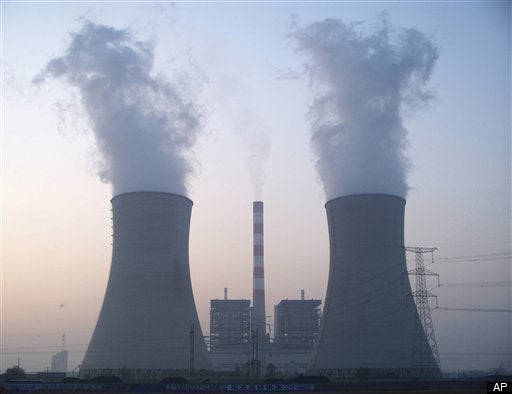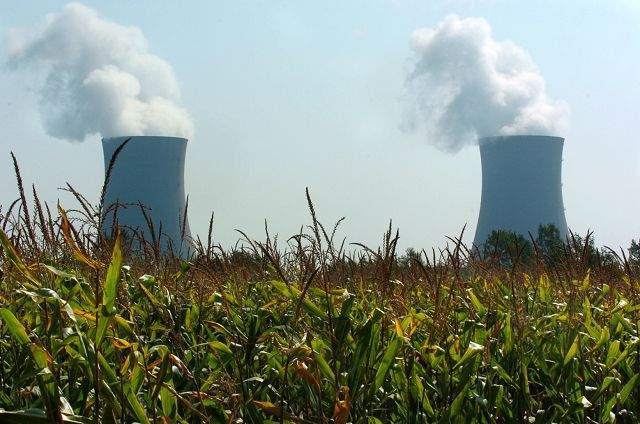
The nuclear power industry's PR machine is trying to drown out nightmares about nuclear meltdowns with the legitimate fears of melting ice caps, rising sea levels, desertification and planetary disruption of Biblical proportions brought on by global warming. Amid this atmospheric sea change, the industry is hoping to have its once-dreaded technology embraced over the next two weeks at the United Nations Climate Change Conference in Copenhagen.
But many believe this re-branding of nuclear power as the safe, new, "green" energy source is dangerously misleading and that if the U. S. and other countries divert their attention and resources to nukes there won't be enough money available to pursue solar, wind and other alternatives.
"The climate change problem is so urgent we have to do everything at once and, indeed, the problem is alarming and yet that's a fundamentally fallacious way of approaching the solution to it. We can't afford to do everything at once," said Peter Bradford, a former U.S. Nuclear Regulatory Commissioner and currently the vice chair of the Union of Concerned Scientists.
Speaking at an Environmental Law Institute panel, Bradford went on to say, "Some solutions foreclose others. If you had a house with a leaky roof, one approach to that would be fix the roof. Another, the more nuclear approach, would be put in a second furnace. The one thing no sensible person would try is doing both of those things at the same time. You prioritize and we're going to have to prioritize if we're going to reach an economically acceptable and sensible resolution to climate issues as well."
Under the mantle of earth-friendly green power, the domestic nuclear industry rushed to submit new reactor license applications - 26 altogether by the end of 2008. These were the first new applications in over 30 years, but the idea of a "nuclear renaissance" may be illusory, since none involve a firm commitment, and were primarily submitted in order to qualify for Federal loan guarantees set aside for the first 2 or 3 reactors. So far, none have started construction in this country.
"The main problem is cost, they have to get financing" and "no one is putting up real money," said former Nuclear Regulatory Commissioner (NRC) Victor Gilinsky when asked what's holding up the nuclear power revival.
A few of the license applications are beginning to wend their way through a slimmed down administrative process.
"The problem that these plants are running into is that the cost estimates keep going up. The cost estimates for new units today are four times what they were when the industry was putting them forth in 2002, 2003," said Bradford.
As the costs escalated, the financial markets collapsed which was accompanied by a decline of manufacturing and massive unemployment. This led to a lessening in demand for power. Add in the declining cost of alternatives and it becomes more difficult to find funding for new nuclear power plants.
"Seeking to override the verdict of the marketplace, the industry's lobbying arm has demanded massive increases in subsidies from taxpayers and ratepayers to underwrite the industry. The last time the nuclear industry circumvented the judgment of the marketplace, it resulted in what Forbes magazine called the "largest managerial failure in American history," wrote Dr. Mark Cooper, a senior fellow for economic analysis at the Institute for Energy and the Environment at Vermont Law School in a recent report.
"The past could be the prologue. A repetition of that history with taxpayers and ratepayers as the underwriters of nuclear reactors would cost not just hundreds of billions in losses for taxpayers on reactors that are canceled, but also trillions in excess costs for ratepayers when reactors are brought to completion by utilities that fail to pursue the lower-cost, less-risky options that are available," said Cooper.
Questions about nuclear power being affordable and practical join the suspicions that the industry hasn't mended its unsafe ways.
The nuclear industry promised to do better this time. The interveners in the Fermi 3 licensing application for a new reactor, slated to be built near Detroit, don't believe much has changed. On November 10 of this year, they filed a request to suspend the proceedings because of the utility's faulty quality assurance program.
The interveners were first alerted to problems at the proposed new reactor when they spotted a memo, dated June 23, 2009, on the Nuclear Regulatory Commission (NRC) website. The memo addressed a review of quality assurance in the design process by Detroit Edison (DTE). It said these "are of sufficient concern at this time that they might question the quality of the overall application."
The NRC found was that the company had no quality assurance program in place from March 2007 to February 2008.
"In addition to not having a program at all, and not tracking this for a year, they were categorizing important work as 'non-safety related' which means they don't have to meet regulatory standards," said Daniel Hirsch, president of the nuclear research group, the Committee to Bridge the Gap.
Quality assurance at an operating nuclear reactor or in the design phase is critical according to David Lochbaum, former director of the Nuclear Safety Project at the Union of Concerned Scientists during Senate testimony in 2006.
"More than 70% of the year-plus outages at U.S. nuclear power reactors over the past four decades have been caused by quality assurance breakdowns," said Lochbaum. "Which could someday factor in a tragic nuclear plant accident."
After further inspections of the records for the proposed Fermi 3 reactor, the NRC issued a formal "Notice of Violation" on October 5, 2009. This prompted the interveners to request the application process be stopped.
"It's not something you can backfill," said Michael Keegan of Don't Waste Michigan. "If engineering's not supported by quality assurance, it's fudged."
The proposed reactor type, the Economically Simplified Boiling Water Reactor (ESBWR) is a brand new design from a partnership between General Electric and Hitachi. "This is an untried reactor, never been built, and quality assurance is a double check," said Terry Lodge, attorney for the interveners. "It's the stage when reality is tested."
The interveners are leery about the company's quality assurance track record. This new reactor would be built on the site where the Fermi I plant suffered a partial meltdown in October 1966 that was due to not following quality assurance procedures. That accident, chronicled in the book, We Almost Lost Detroit, could have rendered a large portion of that city uninhabitable, killed thousands of people and cost of billions of dollars to clean up.
When the inspectors finally got in and had a look at the reactor core they saw some scattered metal pieces they thought might have come from a beer can left behind by an employee during construction. In fact, it was the scattered bits of a zirconium shield that "was not on the blueprints," according to Hirsch.
The shield had been improperly welded and it broke off, clogging the coolant flow, which led to the core melting. But since there was lax quality assurance, the need for the shield, let alone its existence, was never properly addressed.
After costing ratepayers $132-million for repairs Fermi I was finally restarted and ran periodically for two years. Failing to receive approval for a license extension, it was shut down in 1972 after operating for approximately 540 hours - about three weeks in total. The reactor that replaced it, Fermi II, experienced a turbine explosion on Christmas day 1993 that closed it for nearly a year.
"Near disasters and economic disasters," said Lodge who's afraid the current Quality Assurance Violations are another example of the company's inability to safely manage a project. "This is difficult technology, fraught with human imperfections that can become a disaster," he said. "There has to be some discussion about canceling this."
"It's said that those who forget the lessons of the past are condemned to repeat them, and repeat them, and repeat them," said Hirsch, in Senate testimony last year
Let's hope the delegates heading to Copenhagen to create a new energy future remember the problems of the past. Resolving to free up the financial resources needed to invest in a portfolio of renewable energy technologies and energy efficiency would be wiser than chasing the nuclear dream of power once touted as "too cheap to meter."

